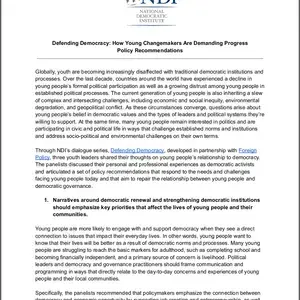A new NDI publication, Political-Process Monitoring: Considering the Outcomes and How They Can Be Measured, helps inform the design and evaluation of programs supporting political-process monitoring. Political-process monitoring refers to a range of citizen or civil society organization (CSO)-driven initiatives that encourage government accountability by monitoring government institutions and actors and reporting on their actions. The new guide builds on Political-Process Monitoring: Activist Tools and Techniques, which the Institute published last year.
To complement that toolkit, this guide offers an explanation of the outcomes that may result from political-process monitoring, how the outcomes can be measured, and why the outcomes matter for democratization.
This guide is unique in that it represents an initial attempt by NDI to consider such outcomes in light of a theory of change. A theory of change describes how and why change happens. In this case, citizen participation plays a key role creating change. The research informing the guide suggests that political-process monitoring initiatives are a form of participation that citizens can undertake effectively in different environments as a way to foster interactions with public officials and set the stage for greater government accountability.
The guide is divided into two sections. Section One frames the research, discusses findings and provides a matrix that aligns outcomes related to citizen voice, political space, and government accountability with different types of monitoring. Also explored are changes that seem to occur when voice, space and accountability intersect during political-process monitoring initiatives. This section concludes with a set of baseline questions to consider, and with four country-specific case studies. Section Two focuses on the approach and corresponding tools used to capture the outcomes detailed in Section One. The tools are flexible and can be tailored for use when mapping outcomes or trying to capture significant changes resulting from other programs as well.
This guide was written with support from the National Endowment for Democracy.




